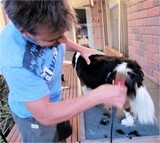Zinc is a trace element obligatory for the operation of more than seventy metalloenzymes in an animal's body. A dog's physiology requires certain amounts of zinc, but the consumption of materials containing zinc will usually create toxic levels. This metal is found in many items, including galvanized surfaces, batteries, wood preservatives, screws and nuts, supplements, creams, and many others. Since 1983, the penny has been consisting of approximately 96% zinc ( 2,440 mg / penny ). Consumption of pennies is the most typically recognized reason for zinc intoxication in dogs. A penny's shinny copper color draws the attention of canines who will at the least need to sniff the coins when left in a location dogs have access to. A coins texture and size appears to draw both children and dogs to placing the coin in their mouths. The swallowing is generally accidental but a common end result to the coin being in the mouth.
The LD50 of zinc salts is 100 mg / kg ( approximately one penny for a 50-lb dog ). Once ingested, the acidic environment of the belly leads to formation of zinc salts, which are then soaked up in the duodenum and distributed to several tissues. The chemical reaction between zinc and stomach acid ( hydrochloric acid ) is analogous to that in wet cell batteries and would likely be caustic to the stomach lining. A survey by the North American Society for the Prevention of Cruelty to Animals and the Animal Poison Control Center revealed that the most typical signs were anemia ( 72% ), depression ( 66% ), barfing ( 61% ), hemolysis ( 33% ), hemoglobinuria ( 22% ), and renal aberrations ( 22% ).
Elimination of zinc is generally fecal through pancreatic excretions, bile, and gastrointestinal ( GI ) mucosa, though some is also eliminated through pee. At this dose, zinc can cause a variety of signs based primarily on potential effects on red blood cell production, kidneys, pancreas, GI mucosa, and possible liver damage. The categorical mechanism of hemolysis isn't known but the damage to red blood cells causes the release of hemoglobin into a dog's body. Chances include direct red blood cell damage to membranes, damage to organelles, immune-mediated destruction from hapten formation, or inhibition of biochemical functions required for protection of red blood cells.
Dog owners should seek medical assistance from their vets when a dog has ingested metal objects noting that pennies and zinc are extremely harmful and need immediate treatment. It is crucial to keep circulation to the kidneys at acceptable levels to prevent renal failure. The University of Maryland suggests administering lots of fluids. Preferably milk must be taken as a fast first aid. Dogs enjoy the flavor of milk and owners should be able to get their dog's to consume acceptable amounts to attenuate the interplay of stomach acid and the metal ingested. Emergency vet facilities should be able to perform nasogastric suction or gastric lavage, by which the contents of the gut are washed out, this procedure, could be resorted to depending on the seriousness of poisoning. Antidotes are also administered to reverse the effects of zinc poisoning. In dogs with severe anemia and hypocupremia, transfusion of red blood cells and measurement of ceruloplasmin and serum copper are done.

 Top Dog Friendly Beaches Around The Uk
Top Dog Friendly
Top Dog Friendly Beaches Around The Uk
Top Dog Friendly
 In These Modern Days Animals Need Recreation Too
In These Modern Days Animals Need Recreation Too
In These Modern Days Animals Need Recreation Too
In These Modern Days Animals Need Recreation Too
 Top Tips On How To Clean Up After Your Kitty
Top Tips On How T
Top Tips On How To Clean Up After Your Kitty
Top Tips On How T
 Read this Article if You are Against Abuse to Animals
Read this Article if You are Against Abuse to Animals
 What to look for in a dog clipper
What to look for in a dog clipper